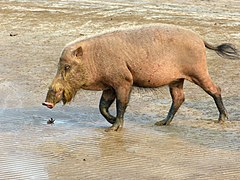Świnie (podrodzina ssaków)
| Suinae[1] | |||||
| J.E. Gray, 1821[2] | |||||
 Przedstawiciel podrodziny – świnia brodata (Sus barbatus) | |||||
| Systematyka | |||||
| Domena | |||||
|---|---|---|---|---|---|
| Królestwo | |||||
| Typ | |||||
| Podtyp | |||||
| Gromada | |||||
| Podgromada | |||||
| Infragromada | |||||
| Nadrząd | |||||
| Rząd | |||||
| Podrząd | |||||
| Rodzina | |||||
| Podrodzina | świnie | ||||
| Typ nomenklatoryczny | |||||
Sus Linnaeus, 1758 | |||||
| |||||
| Rodzaje | |||||
| |||||
Świnie[21], babirussy[21], guźce[21], dzikany[21] (Suinae) – podrodzina ssaków parzystokopytnych z rodziny świniowatych (Suidae).
Zasięg występowania
Podrodzina obejmuje gatunki występujące w Eurazji i w Afryce[22][23].
Systematyka
Podrodzina Suinae skupia wszystkie występujące współcześnie gatunki świniowatych[24]. Do podrodziny należą następujące rodzaje[22][21]:
- Babyrousa Perry, 1811 – babirussa
- Phacochoerus F. Cuvier, 1826 – guziec
- Hylochoerus O. Thomas, 1904 – dzikacz – jedynym przedstawicielem jest Hylochoerus meinertzhageni O. Thomas, 1904 – dzikacz leśny
- Potamochoerus J.E. Gray, 1854 – dzikan
- Porcula Hodgson, 1847 – świneczka – jedynym żyjącym współcześnie przedstawicielem jest Porcula salvania Hodgson, 1847 – świneczka karłowata
- Sus Linnaeus, 1758 – świnia
Opisano również rodzaje wymarłe:
- Celebochoerus Hooijer, 1948[25]
- Hippohyus Falconer & Cautley, 1840[26]
- Hippopotamodon Lydekker, 1877[27]
- Kolpochoerus E.C.N. Van Hoepen & H.E. Van Hoepen, 1932[28]
- Metridiochoerus Hopwood, 1926[29]
- Molarochoerus Liu & Pan, 2003[30]
- Notochoerus Broom, 1925[31]
- Potamochoeroides Dale, 1948[32]
- Propotamochoerus Pilgrim, 1925[33]
- Sivahyus Pilgrim, 1926[34]
Uwagi
- ↑ a b c d e f g h Typ nomenklatoryczny: Sus Linnaeus, 1758.
- ↑ Typ nomenklatoryczny: Porcus S.D.W., 1836 (= Sus Linnaeus, 1758).
- ↑ a b Typ nomenklatoryczny: Babirussa Frisch, 1775 (= Babyrousa Perry, 1811).
- ↑ a b c d Typ nomenklatoryczny: Phacochoerus F. Cuvier, 1826.
- ↑ a b Typ nomenklatoryczny: Potamochoerus J.E. Gray, 1854.
- ↑ Typ nomenklatoryczny: Babyrousa Perry, 1811.
- ↑ Typ nomenklatoryczny: †Hippohyus Falconer & Cautley, 1840.
- ↑ Typ nomenklatoryczny: †Dicoryphochoerus Pilgrim, 1925 (= Hippopotamodon Lydekker, 1877).
- ↑ Typ nomenklatoryczny: †Propotamochoerus Pilgrim, 1925.
Przypisy
- ↑ Suinae, [w:] Integrated Taxonomic Information System [online] (ang.).
- ↑ J.E. Gray. On the Natural Arrangment of Vertebrose Animals. „The London Medical Repository”. 15, s. 306, 1821. (ang.).
- ↑ J.E. Gray. An Outline of an Attempt at the Disposition of Mammalia into Tribes and Families, with a List of the Genera apparently appertaining to each Tribe. „Annals of Philosophy”. New Series. 10, s. 343, 1825. (ang.).
- ↑ S.D.W.. The mammals of Britain systematically arranged. „The Analyst”. 4, s. 71, 1836. (ang.).
- ↑ Gray 1868 ↓, s. 20.
- ↑ Gray 1868 ↓, s. 21.
- ↑ Gray 1868 ↓, s. 45.
- ↑ J.E. Gray. Observations on pigs (Sus, Linnæus; Setifera, Illiger) and their skulls, with the description of a new species. „The Annals and Magazine of Natural History”. Forth Series. 11, s. 434, 1873. (ang.).
- ↑ E.D. Cope. The Classification and Phylogeny of the Artiodactyla. „Proceedings of the American Philosophical Society held at Philadelphia for promoting useful knowledge”. 24, s. 381, 1887. (ang.).
- ↑ K.A. von Zittel: Handbuch der palaeontologie. Cz. 4. München: R. Oldenbourg, 1893, s. 343. (niem.).
- ↑ a b c E. Haeckel: Systematische phylogenie. T. 3. Berlin: Georg Reimer, 1895, s. 555. (niem.).
- ↑ H. Winge: Jordfundne og nulevende hovdyr (Ungulata) fra Lagoa Santa, Minas Geraes, Brasilien: med udsigt over hovdyrenes indbyrdes slægtskab. Kjøbenhavn: H. Hagerup, 1906, s. 70, seria: E Museo Lundii. Triede Bind. Første halvbind. (duń.).
- ↑ M. Hilzheimer & L. Heck: Die Säugetiere: Paarhufer. Leipzig: Bibliographisches Institut, 1925, s. 1—379, seria: Brehms Tierleben 13. (niem.).
- ↑ van Hoepen i van Hoepen 1932 ↓, s. 61.
- ↑ Leakey 1965 ↓, s. 28.
- ↑ Leakey 1965 ↓, s. 33.
- ↑ Thenius 1970 ↓, s. 326.
- ↑ a b Thenius 1970 ↓, s. 327.
- ↑ N. Schmidt-Kittler. Die obermiozäne Fossillager-stätte Sandelzhausen 3. Suidae, Artiodactyla, Mammalia. „Mitteilungen der Bayerischen Staatssammlung für Paläontologie und historische Geologie”. 11, s. 160, 1971. (niem.).
- ↑ M. Pickford. Old World Suoid Systematics, Phylogeny, Biogeography and Biostratigraphy. „Paleontologia i evolució”. 26–27, s. 237–269, 1993. (ang.).
- ↑ a b c d e Nazwy zwyczajowe za: W. Cichocki, A. Ważna, J. Cichocki, E. Rajska-Jurgiel, A. Jasiński & W. Bogdanowicz: Polskie nazewnictwo ssaków świata. Warszawa: Muzeum i Instytut Zoologii PAN, 2015, s. 167-168. ISBN 978-83-88147-15-9. (pol. • ang.).
- ↑ a b C.J. Burgin, D.E. Wilson, R.A. Mittermeier, A.B. Rylands, T.E. Lacher & W. Sechrest: Illustrated Checklist of the Mammals of the World. Cz. 2: Eulipotyphla to Carnivora. Barcelona: Lynx Edicions, 2020, s. 378–382. ISBN 978-84-16728-35-0. (ang.).
- ↑ D.E. Wilson & D.M. Reeder (red. red.): Subfamily Suinae. [w:] Mammal Species of the World. A Taxonomic and Geographic Reference (Wyd. 3) [on-line]. Johns Hopkins University Press, 2005. [dostęp 2021-05-02]. (ang.).
- ↑ M.C. McKenna, S.K. Bell: Classification of mammals above the species level. New York: Columbia University Press, 1997, s. 394. ISBN 0-231-52853-1. (ang.).
- ↑ D.A. Hooijer. Pleistocene vertebrates from Celebes. I. Celebochoerus heekereni nov. gen. nov. spec. „Proceedings of the Koninklijke Nederlandse Akademie van Wetenschappen”. 51 (8). s. 1025rok = 1948. (ang.).
- ↑ H. Falconer & P.T. Cautley: Hippohyus. W: R. Owen: Odontography: or a treatise on the comparative anatomy of the teeth, their physiological relations, mode of development and microscopic structure, in the vertebrate animals. London: Hippolyte Baillier, s. 562. (ang.).
- ↑ R. Lydekker. Notices of new or rare Mammals from the Siwaliks. „Records of the geological survey of India”. 10, s. 81, 1877. (ang.).
- ↑ van Hoepen i van Hoepen 1932 ↓, s. 59.
- ↑ A.T. Hopwood. Some Mammalia from the Pliocene of Homa Mountain, Victoria Nyanza. „The Annals and Magazine of Natural History”. Ninth series. 18 (105), s. 267, 1926. DOI: 10.1080/00222932608633508. (ang.).
- ↑ J.H. Liu & Y.R. Pan. A new suid from the Upper Miocene hominoid locality in Yuanmou of Yunnan Province. „Yunnan Geology”. 22 (2), s. 176–191, 2003. (ang.).
- ↑ R. Broom. On evidence of a Giant Pig from the late Tertiaries of South Africa. „Records of the Albany Museum”. 3, s. 308, 1925. (ang.).
- ↑ M.M. Dale. New fossil Suidae from the Limeworks quarry, Makapansgat, Potgietersrust. „South African Journal of Science”. 2, s. 116, 1848. (ang.).
- ↑ G.E. Pilgrim: Presidential address to the geological section of the 12th Indian Science company. W: Indian Science Congress Association: Proceedings of the 12th Indian Science Congress. Calcutta: Asiatic Society of Bengal, 1925, s. 207. (ang.).
- ↑ G.E. Pilgrim. The fossil Suidae of India. „Memoirs of the Geological Survey of India, Palaeontologia Indica”. 8, s. 52, 1926. (ang.).
Bibliografia
- J.E. Gray. Synopsis of the Species of Pigs (Suidæ) in the British Museum. „Proceedings of the Zoological Society of London”. 1868, s. 17–49, 1868. (ang.).
- E.C.N. van Hoepen & H.E. van Hoepen. Vrystaatse wilde varke. „Paleontologiese Navorsing van die Nasionale Museum”. 2, s. 39−62, 1932. (niderl.).
- L.S.B. Leakey: Mammalian fauna: other than Bovidae. W: L.S.B. Leakey: Olduvai Gorge 1951-61. Cz. 1: Fauna and Background. Cambridge: Cambridge University Press, 1965, s. 12–36. (ang.).
- E. Thenius. Zur Evolution und Verbreitungsgeschichte der Suidae (Artiodactyla, Mammalia). „Zeitschrift für Säugetierkunde”. 35, s. 321–342, 1970. (niem.).
Media użyte na tej stronie
Autor: (of code) -xfi-, Licencja: CC BY-SA 3.0
The Wikispecies logo created by Zephram Stark based on a concept design by Jeremykemp.
Autor: Bernard DUPONT from FRANCE, Licencja: CC BY-SA 2.0
Bako NP, Sarawak, MALAYSIA

